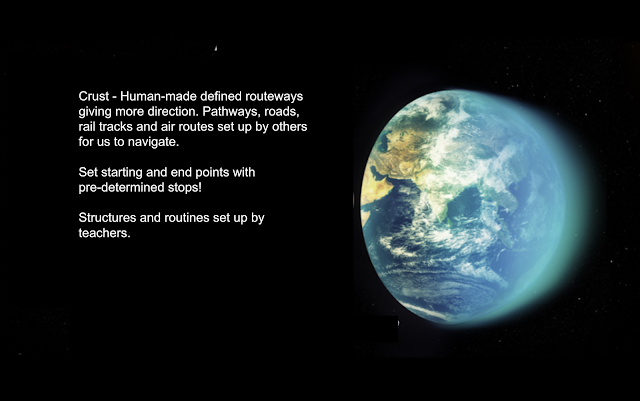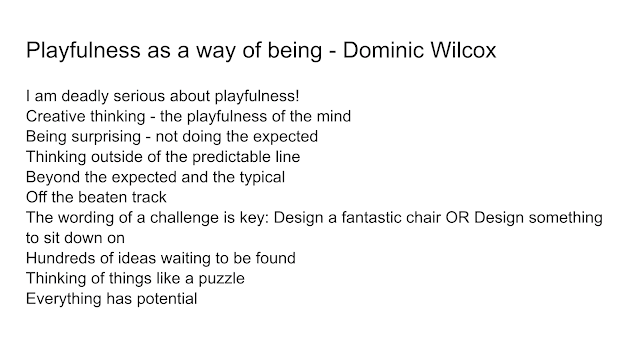Playing with Play and Thinking Playfully about Playful Learning
This blog post offers a visual analogy to capture some of my thinking about the connections between play and playful learning.
The core of the Earth helps us to consider how play is at the heart of a child's learning and in so many domains such as social, emotional, physical and cognitive development. Play is described and defined in many ways by so many including a process, an activity, a strategy, a state of mind, an opportunity... To be mindful of and to protect children's time to play each day (both indoors and outdoors) for a minimum of 2.5 hours each day in the Kindergarten class I teach, I hold onto Peter Gray's criteria for play which position children as the ones making the choices and directing their own play.
There are many different 'types' of play and educators may name and categorise these differently. Regardless of the type, there are no limits to what might happen. There are infinite possibilities for children to engage with materials, ideas and places, so therefore endless opportunities.
Here are some of the ways Kindergarten children have played in the past few days:
- using face paints to transform themselves into different characters
- playing Snakes and Ladders
- experimenting with lines, colours and patterns on the SmartBoard
- designing spinners using Lego
- setting up a restaurant for role play
- painting with watercolours
- exploring balance with wheels and planks
- experimenting with sounds from percussion instruments
- constructing with Magna Tiles
- searching for worms at the nature trail
In contrast to the openness of play, Earth's crust is more fixed and structured. Many of the ways to navigate the crust have been created by humans to give direction from fixed starting points and clear destinations, with pre-planned stops along the way. The intention here is not to present these structures as 'wrong'. The Earth's crust is a reality and it serves a purpose! It has different qualities to the core. In school, the crust represents more adult-initiated engagements, but there can still be scope for children to take initiative.
As part of the online community PressPlay, I was lucky enough to attend a live session with inventor Dominic Wilcox. He shared his thinking about playfulness as a way of being, a mindset, an approach and a stance that one can bring to all aspects of learning and life in general. Playfulness is naturally a part of play, but what I find exciting is the potential to explore playfulness as a 'magnetic force' that is present through Earth, and therefore a child's world.
How might you nurture playfulness beyond play, in some of the routines and structures that guide students to more specific understandings and outcomes? Being playful might mean interacting physically with concrete 'things' or it might be more abstract and being playful with ideas. I am trying to actively seek opportunities to make learning more playful. A constant source of inspiration are the children themselves - looking at and listening to what they do to, how they do it, what their interests are and what motivates them in their play.
Here are 10 examples from the Kindergarten class I teach:
- Continued access to loose parts and materials (clay, shells, buttons, corks, bottle tops, twigs, petals, gemstones, mosaics, Lego...) to plan a piece of writing such as a story.
- The answer is 10. What might the question be?
- Games with specific sounds to be explicit about phonics (drawing words with a specific sound to develop vocabulary, hiding words in the class for scavenger words, building words with magnetic letters or letter blocks, games such as I Spy, word searches, Hangman (that I have renamed 'Sad') and adaptations of spelling bees)
- Tidying up routine - How many things can you find that are hiding from you?
- Morning messages with intriguing visuals, open-ended questions and/or a creative invitation.
- Be playful yourself! Use of humour, language (what if...? I wonder...) and being intentional and explicit about examples of your own playfulness in and out of school
- Use media to highlight broad examples of playfulness - videos, photographs, literature, current affairs...
- Notice and name it! This week, two children were explaining creativity. One said it was doing things we don't normally do. Another said it was putting two things together that don't usually go together. These words will next be used as an invitation to the whole class to be playful. Noticing and naming ideas show we value them.
- When focusing on a reading strategy, challenge yourself to go beyond the obvious. We are currently exploring the strategy of making predictions. Children have had the chance to draw, build, create and role play their predictions to be more playful. We will soon do 'Hot Seating'.
- Create a safe place where risks are encouraged and mistakes are seen as opportunities to learn. A culture of openness to different perspectives and multiple ways of interpreting ideas is key.
We have an important role as educators to celebrate times when we see children trying something new, something for the first time, something original, something no one else has tried yet!
Today, we read If... by Sarah Perry in Kindergarten. Children were struck by the imagination of the illustrations and ideas, and engaged in creative thinking to consider what this would mean if these things were a reality! (If worms had wheels..., If butterflies were clothes...)
Later, we took the time to think about what 'creative thinking' actually means, and then used 'What if...' statements to frame our play. Examples children developed were: What if the mosaic tiles were pieces of a rainbow? What if our photos on sticks were worms? What if the plastic shapes were moving lights?








Comments
Post a Comment